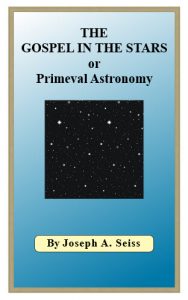IT may seem adventurous to propose to read the Gospel of Christ from what Herschel calls “those uncouth figures and outlines of men and monsters usually scribbled over celestial globes and maps.” So it once would have seemed to the writer. But a just estimate of the case cannot be formed without a close survey of what these figures are, what relations they bear to each other, whence they originated, and what meaning was attached to them by the most ancient peoples from whom they have been transmitted to us. Such a survey the author of this volume has endeavoured to make. From an extended induction he has also reached conclusions which lead him to think he may do good service by giving publicity to the results of his examinations.
The current explanations of the origin and meaning of the constellations certainly are not such as should satisfy those in search of positive truth. Herschel characterizes them as ” puerile and absurd.” They are nowhere to be found outside of Greece and Rome and modern works which have thence derived them. They are part of the staple in the theories and arguments of infidelity. The more ancient and explanations to do away with the intended conclusion as a non sequitur. The argument of these infidels is indeed fatally defective, especially in assuming that the old astronomy throughout, and all the myths and worships associated with it, have come solely from the natural observation and imagination of man, apart from all supernatural light, revelation, or inspiration. With this starting-point unproven and incapable of verification, and with the positive assertions of all the primeval world and all the indications directly to the contrary, the whole argument necessarily breaks down. Like all the efforts of unbelief, it signally fails. But though the argument, as such, is false and worthless, it does not follow that the materials collected to build it are the same. For the most part, they are solid enough in themselves, and the gathering of them was a valuable contribution to a better cause. The showings made of the close likeness between the old constellations and the Gospel are well founded, and can now be illustrated to a much greater and more minute extent. But, instead of proving Christianity a mere revival of old mythologies, they give powerful impulse toward the conclusion that the constellations and their associated myths and traditions are themselves, in their original, from the very same prophetic Spirit whence the Sacred Scriptures have come, and that they are of a piece with the biblical records in the system of God’s universal enunciations of the Christ.
